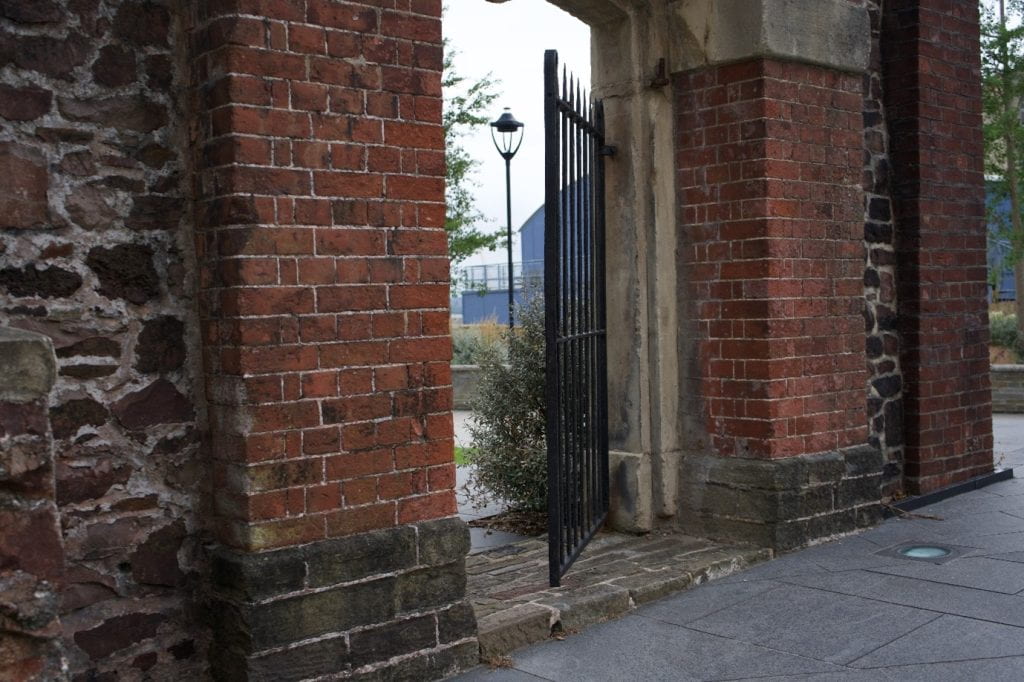Mulch (n) protective covering (as of sawdust, compost, or paper) spread or left on the ground to reduce evaporation, maintain even soil temperature, prevent erosion, control weeds, enrich the soil, or keep fruit (such as strawberries) clean.
Plot (n) patch of land for planting or building on. Plot (n) a plan to achieve (questionable) ends. Plot (n) a storyline.

You are standing at the Ivy Gate, built in the mid-17th century as the entrance to the garden of Cromwell House, now owned by the University of Bristol and a popular site for skateboarders. Look through the gate to the East and you will see a bed sown with flowers and shrubs to attract pollinators, with The Hide, a covered space standing against the fence designed so you can observe insect activity; look through to the West and you’ll see shrubs and saplings. If you are here in Autumn or Winter, they should be heavy with berries to attract migratory birds. In Spring and Summer, the foliage will partially obscure the Living Studio, a shelter with a firepit, benches and blackboards – set up to help us break traditional boundaries of learning, to become plotters.
Through the multiple effects of climate change we are experiencing the inextricability of the human and the non-human. Fossil fuel dependence and extractive capitalism are significantly impacting climate and environment and the Intergovernmental Panel on Climate Change warns: ‘the greatest single impact of climate change might be on human movement’. Yet certain kinds of mobility – usually of the poor rather than the flight paths of the wealthy – are decontextualised and focussed on as the root cause of problems: migration destroys carbon sinks; ‘environmental refugees’ put pressure on already scarce resources and so on. Thus, despite their imbrication the politics of climate and the mobility of the poor i.e. ‘migration’, are increasingly framed as oppositional. Migration and environmental politics are increasingly connected through fears of apocalyptic futures of scarcity and ruin, enabling what Geoff Eley writing of Nazism describes as ‘fortress mentalities, idioms of politics organized by anxiety, gatedness as the emerging social paradigm’.
To build justice we must bring thinking and politics on mobility and environmental justice together, – after all, many ‘migrants’ are only too aware of the devastation of failed crops and flooded homes, however marginalised they may be from the environmental politics of the Global North. But our understandings of mobility justice cannot be restricted to humans alone. Human migration is woven into patterns of movement of non-human species, of goods and other things. This plot is an opportunity to learn from the intersections and tensions of movements of humans, pollen, seeds, birds and insects and to draw the resources of imagination, sensibility and embodiment as well as reason. Migration activism often uses analogies from nature like caged birds, monarch butterflies, and anti-migration politics too draws on metaphors of swarms of insects and infestations of pests. We can use analogies as threads that help us unravel the politics and emotions they derive from and inform. We can take material as points from which to orientate understandings of histories to guide us towards more equitable futures. We can observe to re-imagine and re-build our relationships with (non-)human worlds.
Thus, our plot is material and metaphorical. Its materiality has forced us to confront contradictions. For example, the space is designed with hospitality in mind, but there are no nearby toilets. We did not want to allow for people using it for that purpose and worked to design that usage out. It is a plot to germinate and grow critical thinking. These notes are meditative mulch for you to grow your seedlings and take them to plant and nurture in other spaces. As Donna Haraway remarked: “Academia sounds very different if you bring it to humus”.

